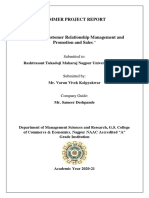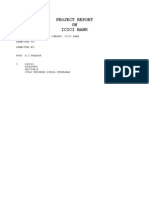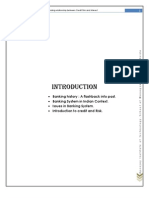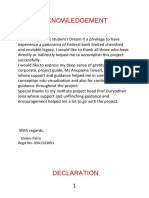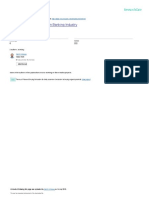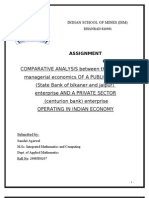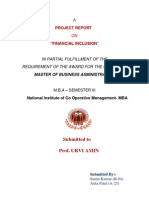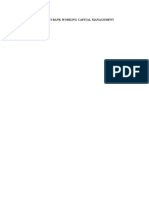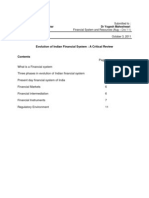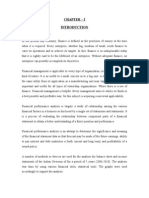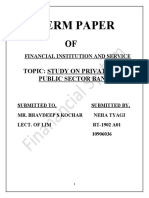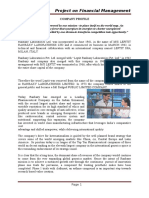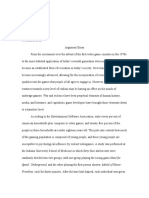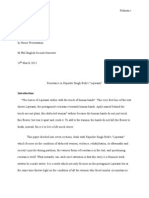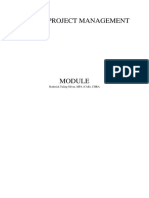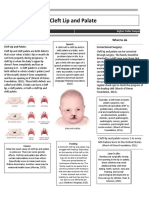Axis Bank
Axis Bank
Uploaded by
Rahul ManwaniCopyright:
Available Formats
Axis Bank
Axis Bank
Uploaded by
Rahul ManwaniOriginal Description:
Original Title
Copyright
Available Formats
Share this document
Did you find this document useful?
Is this content inappropriate?
Copyright:
Available Formats
Axis Bank
Axis Bank
Uploaded by
Rahul ManwaniCopyright:
Available Formats
Project on Organization Behavior of
Axis Bank
BANKING IN INDIA
Without a sound and effective banking system in India it cannot have a healthy economy. The
banking system of India should not only be hassle free but it should be able to meet new
challenges posed by the technology and any other external and internal factors. For the past
three decades India's banking system has several outstanding achievements to its credit. The
most striking is its extensive reach. It is no longer confined to only metropolitans or
cosmopolitans in India. In fact, Indian banking system has reached even to the remote corners
of the country. This is one of the main reasons of India's growth process.
HISTORY:
The first bank in India, though conservative, was established in 1786. From 1786 till today,
the journey of Indian Banking System can be segregated into three distinct phases. They are
as mentioned below:
PHASE I
PHASE II - Nationalization of Indian Banks and up to 1991
PHASE III - Indian Financial & Banking Sector Reforms after 1991.
- Early phase from 1786 to 1969 of Indian Banks
PHASE I:
The General Bank of India was set up in the year 1786. Next came Bank of Hindustan and
Bengal Bank. The East India Company established Bank of Bengal (1809), Bank of Bombay
(1840) and Bank of Madras (1843) as independent units and called it Presidency Banks.
These three banks were amalgamated in 1920 and Imperial Bank of India was established
which started as private shareholders banks, mostly Europeans shareholders. During the first
phase the growth was very slow and banks also experienced periodic failures between 1913
and 1948. There were approximately 1100 banks, mostly small. To streamline the functioning
and activities of commercial banks, the Government of India came up with The Banking
Companies Act, 1949 which was later changed to Banking Regulation Act 1949 as per
amending Act of 1965 (Act No. 23 of 1965). Reserve Bank of India was vested with
extensive powers for the supervision of banking in India as the Central Banking Authority.
During those days public has lesser confidence in the banks. As an aftermath deposit
Project on Organization Behavior of
Axis Bank
mobilization was slow. Abreast of it the savings bank facility provided by the Postal
department was comparatively safer. Moreover, funds were largely given to the traders.
PHASE II:
Government took major steps in this Indian Banking Sector Reform after independence. In
1955, it nationalized Imperial Bank of India with extensive banking facilities on a large scale
especially in rural and semi-urban areas. Second phase of nationalization Indian Banking
Sector Reform was carried out in 1980 with seven more banks. This step brought 80% of the
banking
segment
in
India
under
Government
ownership.
The following are the steps taken by the Government of India to Regulate Banking
Institutions in the Country:
1949: Enactment of Banking Regulation Act.
1955: Nationalization of State Bank of India.
1959: Nationalization of SBI subsidiaries.
1961: Insurance cover extended to deposits.
1969: Nationalization of 14 major banks.
1971: Creation of credit guarantee corporation.
1975: Creation of regional rural banks.
1980: Nationalization of seven banks with deposits over 200 crore.
After the nationalization of banks, the branches of the public sector bank India raised to
approximately 800% in deposits and advances took a huge jump by 11,000%.Banking in the
sunshine of Government ownership gave the public implicit faith and immense confidence
about the sustainability of these institutions.
PHASE III
2
Project on Organization Behavior of
Axis Bank
This phase has introduced many more products and facilities in the banking sector in its
reforms measure. In 1991, under the chairmanship of M Narasimham, a committee was set up
by
his
name
which
worked
for
the
liberalisation
of
banking
practices.
The country is flooded with foreign banks and their ATM stations. Efforts are being put to
give a satisfactory service to customers. Phone banking and net banking is introduced. The
entire system became more convenient and swift. The financial system of India has shown a
great deal of resilience. It is sheltered from any crisis triggered by any external
macroeconomics shock as other East Asian Countries suffered. This is all due to a flexible
exchange rate regime, the foreign reserves are high, the capital account is not yet fully
convertible, and banks and their customers have limited foreign exchange exposure.
COMPANY PROFILE: AXIS BANK
Axis Bank India, the first bank to begin operations as new private banks in 1994 after the
Government of India allowed new private banks to be established. Axis Bank was jointly
promoted by the Administrator of the specified undertaking of the
Unit Trust of India (UTI-I)
Life Insurance Corporation of India (LIC)
General Insurance Corporation Ltd.
Also with associates viz. National Insurance Company Ltd., The New India Assurance
Company, The Oriental Insurance Corporation and United Insurance Company Ltd.
Axis Bank in India today is capitalised with Rs. 232.86 Crores with 47.50% public holding
other than promoters. It has more than 200 branch offices and Extension Counters in the
country with over 1250 Axis Bank ATM proving to be one of the largest ATM networks in the
country. Axis Bank India commits to adopt the best industry practices internationally to
achieve excellence. Axis Bank has strengths in retail as well as corporate banking. By the end
of December 2004, Axis Bank in India had over 2.7 million debit cards. This is the first bank
in India to offer the AT PAR Cheque facility, without any charges, to all its Savings Bank
customers in all the places across the country where it has presence.
EVOLUTION:
Project on Organization Behavior of
Axis Bank
UTI was established in 1964 by an Act of Parliament; neither did the Government of India
own it nor contributes any capital. The RBI was asked to contribute one-half of its initial
capital of Rs 5 crore, and given the mandate of running the UTI in the interest of the unitholders. The State Bank of India and the Life Insurance Corporation contributed 15 per cent
of the capital each, and the rest was contributed by scheduled commercial banks which were
not nationalized then. This kind of structure for a unit trust is not found anywhere else in the
world. Again, unlike other unit trusts and mutual funds, the UTI was not created to earn
profits. In the course of nearly four decades of its existence, it (the UTI) has succeeded
phenomenally in achieving its objective and has the largest share anywhere in the world of
the domestic mutual fund industry.'' The emergence of a "foreign expert" during the setting up
of the UTI makes an interesting story. The announcement by the then Finance Minister that
the Government of India was contemplating the establishment of a unit trust caught the eye of
Mr. George Woods, the then President of the World Bank. Mr. Woods took a great deal of
interest in the Indian financial system
CURRENT SCENARIO:
Organizational behaviour is currently a growing field. Organizational studies departments
generally form part of business schools, although many universities also have industrial
psychology and industrial economics programs.
The field is highly influential in the business world with practitioners like Peter Drucker and
Peter Senge, who turned the academic research into business practices. Organizational
behaviour is becoming more important in the global economy as people with diverse
backgrounds and cultural values have to work together effectively and efficiently. It is also
under increasing criticism as a field for its ethnocentric and pro-capitalist assumptions
During last 20 years organizational behavior study and practice has developed and expanded
through creating integrations with other domains:
Anthropology became an interesting prism to understanding firms as communities,
by introducing concepts like Organizational culture, 'organizational rituals' and
'symbolic acts' enabling new ways to understand organizations as communities.
Project on Organization Behavior of
Axis Bank
Leadership Understanding the crucial role of leadership at various level of an
organization in the process of change management.
Ethics and their importance as pillars of any vision and one of the most important
driving forces in an organization.
Project on Organization Behavior of
Axis Bank
ORGANIZATIONAL CULTURE
Organizational culture is a concept in the field of Organizational studies and management
which describes the attitudes, experiences, beliefs and values of an organization. It has been
defined as "the specific collection of values and norms that are shared by people and groups
in an organization and that control the way they interact with each other and with
stakeholders outside the organization
Strong culture is said to exist where staff respond to stimulus because of their alignment to
organizational values.
Conversely, there is weak culture where there is little alignment with organizational values
and control must be exercised through extensive procedures and bureaucracy.
Where culture is strongpeople do things because they believe it is the right thing to do
there is a risk of another phenomenon, Groupthink. "Groupthink" was described by Irving L.
Janis. He defined it as "...a quick and easy way to refer to a mode of thinking that people
engage when they are deeply involved in a cohesive ingroup, when members' strivings for
unanimity override their motivation to realistically appraise alternatives of action." This is a
state where people, even if they have different ideas, do not challenge organizational
thinking, and therefore there is a reduced capacity for innovative thoughts. This could occur,
for example, where there is heavy reliance on a central charismatic figure in the organization,
or where there is an evangelical belief in the organizations values, or also in groups where a
friendly climate is at the base of their identity (avoidance of conflict). In fact groupthink is
very common, it happens all the time, in almost every group. Members that are defiant are
often turned down or seen as a negative influence by the rest of the group, because they bring
conflict.
Innovative organizations need individuals who are prepared to challenge the status quobe it
groupthink or bureaucracy, and also need procedures to implement new ideas effectively.
ORGANIZATIONAL EFFECTIVENESS
Organizational effectiveness is the concept of how effective an organization is in achieving
the outcomes the organization intends to produce. The idea of organizational effectiveness is
especially important for non-profit organizations as most people who donate money to nonprofit organizations and charities are interested in knowing whether the organization is
effective in accomplishing its goals.
Project on Organization Behavior of
Axis Bank
An organization's effectiveness is also dependent on its communicative competence and
ethics. The relationship between these three is simultaneous. Ethics is a foundation found
within organizational effectiveness. An organization must exemplify respect, honesty,
integrity and equity to allow communicative competence with the participating members.
Along with ethics and communicative competence, members in that particular group can
finally achieve their intended goals Organizational effectiveness is an abstract concept and is
basically impossible to measure. Instead of measuring organizational effectiveness, the
organization determines proxy measures which will be used to represent effectiveness. Proxy
measures used may include such things as number of people served, types and sizes of
population segments served, and the demand within those segments for the services the
organization supplies. For instance, a non-profit organization which supplies meals to house
bound people may collect statistics such as the number of meals cooked and served, the
number of volunteers delivering meals, the turnover and retention rates of volunteers, the
demographics of the people served, the turnover and retention of consumers, the number of
requests for meals turned down due to lack of capacity (amount of food, capacity of meal
preparation facilities, and number of delivery volunteers), and amount of wastage. Since the
organization has as its goal the preparation of meals and the delivery of those meals to house
bound people, it measures its organizational effectiveness by trying to determine what actual
activities the people in the organization do in order to generate the outcomes the organization
wants to create.
Activities such as fundraising or volunteer training are important because they provide the
support needed for the organization to deliver its services but they are not the outcomes per
se. These other activities are overhead activities which assist the organization in achieving its
desired outcomes.
EMPLOYEE ENGAGEMENT
Employee engagement is a concept that is generally viewed as managing discretionary
effort, that is, when employees have choices, they will act in a way that furthers their
organization's interests. An engaged employee is a person who is fully involved in, and
enthusiastic about, his or her work.
Project on Organization Behavior of
Axis Bank
Engaged employees care about the future of the company and are willing to invest the
discretionary effort. Engaged employees feel a strong emotional bond to the organization that
employs them.
FACTORS AFFECTING EMPLOYEE ENGAGEMENT:
Employee perceptions of job importance.
Employee clarity of job expectations. "If expectations are not clear and basic
materials and equipment not provided, negative emotions such as boredom or
resentment may result, and the employee may then become focused on surviving
more than thinking about how he can help the organization succeed."
Career advancement/improvement opportunities. "Plant supervisors and managers
indicated that many plant improvements were being made outside the suggestion
system, where employees initiated changes in order to reap the bonuses generated by
the subsequent cost savings."
Regular feedback and dialogue with superiors. "Feedback is the key to giving
employees a sense of where theyre going, but many organizations are remarkably bad
at giving it. "'What I really wanted to hear was 'Thanks. You did a good job.' But all
my boss did was hand me a check.'
Quality of working relationships with peers, superiors, and subordinates. "...if
employees' relationship with their managers is fractured, then no amount of perks will
persuade the employees to perform at top levels. Employee engagement is a direct
reflection of how employees feel about their relationship with the boss."
Perceptions of the ethos and values of the organization.
EMPLOYEE ENGAGEMENT
Employee engagement is a concept that is generally viewed as managing discretionary
effort, that is, when employees have choices, they will act in a way that furthers their
organization's interests. An engaged employee is a person who is fully involved in, and
enthusiastic about, his or her work.
8
Project on Organization Behavior of
Axis Bank
Engaged employees care about the future of the company and are willing to invest the
discretionary effort. Engaged employees feel a strong emotional bond to the organization that
employs them.
FACTORS AFFECTING EMPLOYEE ENGAGEMENT:
Employee perceptions of job importance.
Employee clarity of job expectations. "If expectations are not clear and basic
materials and equipment not provided, negative emotions such as boredom or
resentment may result, and the employee may then become focused on surviving
more than thinking about how he can help the organization succeed."
Career advancement/improvement opportunities. "Plant supervisors and managers
indicated that many plant improvements were being made outside the suggestion
system, where employees initiated changes in order to reap the bonuses generated by
the subsequent cost savings."
Regular feedback and dialogue with superiors. "Feedback is the key to giving
employees a sense of where theyre going, but many organizations are remarkably bad
at giving it. "'What I really wanted to hear was 'Thanks. You did a good job.' But all
my boss did was hand me a check.'
Quality of working relationships with peers, superiors, and subordinates. "...if
employees' relationship with their managers is fractured, then no amount of perks will
persuade the employees to perform at top levels. Employee engagement is a direct
reflection of how employees feel about their relationship with the boss."
Perceptions of the ethos and values of the organization.
Effective Internal Employee Communications - which convey a clear description of
"what's going on". "'If you accept that employees want to be involved in what they are
doing then this trend is clear (from small businesses to large global organizations).
The effect of poor internal communications is seen as its most destructive in global
organizations which suffer from employee annexation - where the head office in one
Project on Organization Behavior of
Axis Bank
country is buoyant (since they are closest to the action, know what is going on, and
are heavily engaged).
10
Project on Organization Behavior of
Axis Bank
Literature Review
Frederick Winslow Taylor (1856-1915):Taylor was the first person who
attempted to study human behavior at work using a systematic approach. Taylor
studied human characteristics, social environment, task, physical environment,
capacity, speed, durability, cost and their interaction with each other. His overall
objective was to reduce and/or remove human variability. Taylor worked to
achieve his goal of making work behaviors stable and predictable so that
maximum output could be achieved. He relied strongly upon monetary
incentive systems, believing that humans are primarily motivated by money. He
faced some strong criticism, including being accused of telling managers to treat
workers as machines without minds, but his work was very productive and laid
many foundation principles for modern management study.
Elton Mayo: Elton Mayo, an Australian national, headed the Hawthorne
Studies at Harvard. In his classic writing in 1931, Human Problems of an
Industrial Civilization, he advised managers to deal with emotional needs of
employees at work.
Mary Parker Follett: Mary Parker Follett was a pioneer management
consultant in the industrial world. As a writer, she provided analyses on workers
as having complex combinations of attitude, beliefs, and needs. She told
managers to motivate employees on their job performance, a "pull" rather than a
"push" strategy.
Douglas McGregor: Douglas McGregor proposed two theories/assumptions,
which are very nearly the opposite of each other, about human nature based on
his experience as a management consultant. His first theory was Theory X,
which is pessimistic and negative; and according to McGregor it is how
11
Project on Organization Behavior of
Axis Bank
managers traditionally perceive their workers. Then, in order to help managers
replace that theory/assumption, he gave Theory Y which takes a more modern
and positive approach. He believed that managers could achieve more if
managers start perceiving their employees as self-energized, committed,
responsible and creative beings. By means of his Theory Y, he in fact challenged
the traditional theorists to adopt a developmental approach to their employees.
He also wrote a book The Human Side of Enterprise in 1960; this book has
become a foundation for the modern view of employees at work.
12
Project on Organization Behavior of
Axis Bank
Research Methodology
Methodology refers to more than a simple set of methods; rather it refers to the
rationale and the philosophical assumptions that underlie a particular study. This
is why scholarly literature often includes a section on the methodology of the
researchers.
For the purpose of this study, the type of research undertaken was primary
research, which comprised of collecting information through questionnaires
from the selected sample. Primary research is more detailed and it involves
getting close information from the sample directly.
PROCEDURE OF THE STUDY:
The study was conducted by getting questionnaires filled by AXIS Bank
employees. Then the data collected was tabulated and various tools like SPSS
and Microsoft Excel were used for the quantification of the data collected.
INSTRUCTIONS GIVEN `TO SAMPLE INDIVIDUALS:
The employees of AXIS Bank, who were selected as a part of the sample, were told to fill the
questionnaires with legitimate details in the questionnaire. The sample individuals were also
requested to give the true and fair picture of the organization and the working environment of
the organization, as this would help us in getting a fair picture of the organization and help us
get the true findings from the study.
13
Project on Organization Behavior of
Axis Bank
OBJECTIVES OF THE STUDY
The objective of the study is the purpose for which the study is conducted and it is
undertaken. The objective decides the procedure and the path which will be taken for the
study. The objective is the base on which the foundation of the study is built. The
objective should be decided with utmost concentration and due consideration.
The objective of our study is:
To analyze the organizational culture in AXIS Bank
To analyze the employee engagement in AXIS Bank
To analyze organizational effectiveness in AXIS Bank
Research Hypothesis
Researchers form hypotheses "tentative answers for a research question" because the
hypothesis will influence how the research study is conducted. As you'll see in later sections,
there are many methods researchers use to answer research questions. Which method a
researcher chooses will also depend on the hypothesis, i.e. the answer a researcher aims to
find.
Scientists use theories as they develop their research hypotheses. Therefore, in this section,
we first address theories, and then focus on how to develop a hypothesis.
In business research, the theories used are often derived from theories in other disciplines.
For example, psychological theories, such as theory of planned behaviour, are often used to
explain issues in organizational behaviour. Network theories, originally developed by
sociologists, explain how the structure of relationships between different people affect their
behaviour and have successfully applied to investigate which relationships companies form
and maintain, and why they do so. Economic theories in industrial organization form the base
for many considerations in strategic management, such as the framework of competitive
advantage proposed by Porter.
14
Project on Organization Behavior of
Axis Bank
A good theory has to accomplish several things. First, a theory needs to define and describe
the events or phenomena it seeks to explain, and predict when we can expect certain
behaviours or events to occur. Finally, theories must explain the causes of events described in
the theory. These predictions and explanations are tested in research studies.
The process of developing and testing theories follows these steps:
1. Theorists develop their ideas by reviewing all the research evidence for a particular
phenomenon or behaviour.
2. They attempt to organize this evidence into a coherent and logical framework that
explains the phenomenon.
3. Using this theory, new ideas and hypotheses are developed to guide the next research
projects in an area.
4. These new research studies help to refine the theory.
5. The end result is a greater understanding of human behaviour and mental processes.
We built our research on this stream. The work of Coleman and Burt suggests that dense
networks as well as loose networks have beneficial effects. Departing from this, we theorize
that one should look not only at the overall network structure or social embeddedness, but
rather should start to look at the specific relationships and what characterizes them. Thus, we
argue that a network is not sufficiently captured by its structure but also needs to account for
characteristics of the individual relationships.
In one of our studies we derived the following three grand hypotheses.
Potential business starters with personal networks characterized by
(a) Many ties
(b) More diverse ties and
15
Project on Organization Behavior of
Axis Bank
(c) A large share of ties to other self-employed possess more relevant social capital and are
therefore more likely to start a business.
Potential business starters with personal networks characterized by
(a) a high network homogeneity
(b) a high share of closed ties, and
(c) a high share of old ties
increase the quality of resources they can access and are therefore more likely to start a
business.
The larger the proportion of weak ties that are also old or close, in a network, the higher the
chances are to start a business.
16
Project on Organization Behavior of
Axis Bank
DATA ANALYIS
QUESTION -- 1
Does your work group plan together and coordinate its efforts?
Frequency
Percent
Valid Percent
Cumulative Percent
indifferent
10.0
10.0
10.0
Agree
80.0
80.0
90.0
strongly agree
10.0
10.0
100.0
Total
10
100.0
100.0
INFERENCE: From the above findings of the question, the inference that can be drawn is
that most of the employees think or consider that there is planning and coordination among
the various workgroup of the organization. 80% of the total sample agree that there is
planning and coordination among the various workgroups in an organization.
QUESTION-- 2
17
Project on Organization Behavior of
Axis Bank
Does your work group make good decisions and solve problems well?
Frequency
Percent
Valid Percent
Cumulative Percent
Indifferent
10.0
10.0
10.0
Agree
60.0
60.0
70.0
strongly agree
30.0
30.0
100.0
Total
10
100.0
100.0
INFERENCE: The inference drawn is that a majority of the employees feel that their
workgroup makes good decisions and solves problems well. but there is no one who is
against this statement.
QUESTION -- 3
18
Project on Organization Behavior of
Axis Bank
Is information about important events and situations shared within your workgroup?
Valid
Frequency
Percent
Valid Percent
Cumulative Percent
disagree
10.0
10.0
10.0
indifferent
20.0
20.0
30.0
Agree
30.0
30.0
60.0
strongly agree
40.0
40.0
100.0
Total
10
100.0
100.0
INFERENCE: The findings of this question show us that information in the organization
is shared in the organization to an extent. 40% strongly agree. 30% agree, and there is also a
major part(30%) of the employees who disagree or are indifferent.
QUESTION -- 4
19
Project on Organization Behavior of
Axis Bank
Does your workgroup feel responsible for meeting its objectives successfully?
Valid
Frequency
Percent
Valid Percent
Cumulative Percent
indifferent
20.0
20.0
20.0
disagree
60.0
60.0
80.0
strongly disagree
20.0
20.0
100.0
Total
10
100.0
100.0
INFERENCE: The inference that can be drawn is that the workgroup does not feel
responsible about achieving its objectives successfully, but there is also a combined chunk of
employees(40%), who think that the workgroups do feel responsible to meet the objectives
successfully.
QUESTION -- 5
20
Project on Organization Behavior of
Axis Bank
Is your workgroup able to respond to unsual work demands placed upon it?
Valid
Frequency
Percent
Valid Percent
Cumulative Percent
indifferent
60.0
60.0
60.0
Agree
40.0
40.0
100.0
Total
10
100.0
100.0
INFERENCE: the inference is that, if unusual demands are placed upon the workgroup,
the group is either unsuccessful or any type of unusual demand is not placed on it.
21
Project on Organization Behavior of
Axis Bank
QUESTION 6
Do you have confidence and trust in the persons in your workgroup?
Valid
Frequency
Percent
Valid Percent
Cumulative Percent
Disagree
20.0
20.0
20.0
Indifferent
30.0
30.0
50.0
Agree
20.0
20.0
70.0
strongly agree
30.0
30.0
100.0
Total
10
100.0
100.0
INFERENCE: The answer to this question came as a mixed response. Same proportion of
individuals agreed strongly and were indifferent about it. But, the difference between those
who agree and disagree is only 10%, which shows that there is distrust among individuals in
the workgroups.
QUESTION -- 7
22
Project on Organization Behavior of
Axis Bank
Overall, are you satisfied with the persons in your workgroup?
Frequency
Percent
Valid Percent
Cumulative Percent
Indifferent
30.0
30.0
30.0
Agree
40.0
40.0
70.0
strongly agree
30.0
30.0
100.0
Total
10
100.0
100.0
INFERENCE: Majority of the people in the organization are satisfied with the persons in
their workgroups. But 1/3rd of the employees are indifferent towards this.
Conclusion
23
Project on Organization Behavior of
Axis Bank
On the basis of the survey done by us we have come to the following conclusion.
Organization Culture In AXIS BANK, culture plays a significant role. The firm already has
a good organization culture according to the survey done by us. Organization culture is the
unifying and shared patterns of thoughts, freely value and action that serve to bind together
organizational members and distinguish them from non-members. Thus we see that in AXIS,
the organization takes care of most of the employees.
Employee Engagement Employee engagement is a two way communication process between
the employees the organization. After scrutinizing the questionnaire we see that AXIS BANK
has an effective employee engagement. The employees in this firm can readily relate
themselves to the organization. The employees in this organization feel more engaged when
they make unique contribution to the organization. The employee structure of AXIS BANK,
is very loyal to the firm (according to the calculation done). There is little among themselves
and we see that the employees perceive themselves as being unified with the organization.
Organizational Effectiveness. By organizational effectiveness, we mean how effective an
organization is to achieve its goal. In the context of AXIS BANK, we perceive that the firm
has a sound management, strong governance and a willful dedication to achieve its specific
goals. Most of the employees agree with the fact that the organization is effective to
accomplish its target in time.
24
Project on Organization Behavior of
Axis Bank
Bibliography
1) http://www.google.co.in/search?
hl=en&q=employee+blogs+on+hdfc+bank&meta
2) http://www.cuil.com/
3) http://www.wikipedia.org/
4) www.blackle.com
25
Project on Organization Behavior of
Axis Bank
Annexure
QUESTION -- 1
Does your work group plan together and coordinate its efforts?
Frequency
Percent
Valid Percent
Cumulative Percent
indifferent
10.0
10.0
10.0
Agree
80.0
80.0
90.0
strongly agree
10.0
10.0
100.0
Total
10
100.0
100.0
QUESTION-- 2
Does your work group make good decisions and solve problems well?
Frequency
Percent
Valid Percent
Cumulative Percent
Indifferent
10.0
10.0
10.0
Agree
60.0
60.0
70.0
strongly agree
30.0
30.0
100.0
Total
10
100.0
100.0
QUESTION -- 3
Is information about important events and situations shared within your workgroup?
Valid
Frequency
Percent
Valid Percent
Cumulative Percent
disagree
10.0
10.0
10.0
indifferent
20.0
20.0
30.0
Agree
30.0
30.0
60.0
strongly agree
40.0
40.0
100.0
Total
10
100.0
100.0
QUESTION -- 4
26
Project on Organization Behavior of
Axis Bank
Does your workgroup feel responsible for meeting its objectives successfully?
Valid
Frequency
Percent
Valid Percent
Cumulative Percent
indifferent
20.0
20.0
20.0
disagree
60.0
60.0
80.0
strongly disagree
20.0
20.0
100.0
Total
10
100.0
100.0
QUESTION -- 5
Is your workgroup able to respond to unsual work demands placed upon it?
Valid
Frequency
Percent
Valid Percent
Cumulative Percent
indifferent
60.0
60.0
60.0
Agree
40.0
40.0
100.0
Total
10
100.0
100.0
QUESTION 6
Do you have confidence and trust in the persons in your workgroup?
Valid
Frequency
Percent
Valid Percent
Cumulative Percent
Disagree
20.0
20.0
20.0
Indifferent
30.0
30.0
50.0
Agree
20.0
20.0
70.0
strongly agree
30.0
30.0
100.0
Total
10
100.0
100.0
QUESTION -- 7
27
Project on Organization Behavior of
Axis Bank
Overall, are you satisfied with the persons in your workgroup?
28
Frequency
Percent
Valid Percent
Cumulative Percent
Indifferent
30.0
30.0
30.0
Agree
40.0
40.0
70.0
strongly agree
30.0
30.0
100.0
Total
10
100.0
100.0
You might also like
- Recruitment Process Outsourcing A Complete Guide - 2020 EditionFrom EverandRecruitment Process Outsourcing A Complete Guide - 2020 EditionNo ratings yet
- Project Report PDFDocument27 pagesProject Report PDFGOURAB BANIK Umeschandra CollegeNo ratings yet
- Introduction To Organization StudyDocument50 pagesIntroduction To Organization Studysimply_cooolNo ratings yet
- Sip CRMDocument33 pagesSip CRMADITYA KUMAR GAUTAMNo ratings yet
- Recruitment and Selection in Banking Ind PDFDocument28 pagesRecruitment and Selection in Banking Ind PDFBhawna RawatNo ratings yet
- Ashwini G Report On Axis BankDocument49 pagesAshwini G Report On Axis BankVishwas DeveeraNo ratings yet
- Chapter 1Document37 pagesChapter 1Kalyan Reddy AnuguNo ratings yet
- Chapter - 1 Introduction To The Industry: 1.1 Banking in IndiaDocument58 pagesChapter - 1 Introduction To The Industry: 1.1 Banking in IndiaFaheem QaziNo ratings yet
- Mba 04Document7 pagesMba 04Sarthak DhananiNo ratings yet
- Banking ProjectDocument25 pagesBanking Projectrupali jani0% (1)
- Impact of Technology On Indian BanksDocument63 pagesImpact of Technology On Indian BanksAnoop Chahal0% (1)
- Project Report On Icici BankDocument44 pagesProject Report On Icici BankRoyal Projects75% (4)
- Tybbi Comparative Study of Strategy Implemented in BankDocument37 pagesTybbi Comparative Study of Strategy Implemented in BankPranav ViraNo ratings yet
- Non Performing AssetsDocument89 pagesNon Performing AssetsNazma MalikNo ratings yet
- Sbi and HDFC Comparative Study of Customer S Satisfaction TowardsDocument67 pagesSbi and HDFC Comparative Study of Customer S Satisfaction TowardsMõørthï Shãrmâ75% (4)
- Banking History: A Flashback Into Past. Banking System in Indian Context. Issues in Banking System. Introduction To Credit and RiskDocument84 pagesBanking History: A Flashback Into Past. Banking System in Indian Context. Issues in Banking System. Introduction To Credit and RiskMinhaz Iqbal HazarikaNo ratings yet
- Project Report On Role of Banks in Indian EconomyDocument29 pagesProject Report On Role of Banks in Indian EconomyNeeraj UpadhyayNo ratings yet
- Thesis On Commercial Banks in IndiaDocument6 pagesThesis On Commercial Banks in IndiaWriteMyPaperReviewsSouthBend100% (1)
- My Sip ProjectDocument47 pagesMy Sip Projectboom4rajNo ratings yet
- Recruitment and Selection in Banking Industry: December 2017Document56 pagesRecruitment and Selection in Banking Industry: December 2017santunusorenNo ratings yet
- Sbi and Hdfc"COMPARATIVE STUDY OF CUSTOMER'S SATISFACTION TOWARDS HDFC BANK AND STATE BANK OF INDIADocument68 pagesSbi and Hdfc"COMPARATIVE STUDY OF CUSTOMER'S SATISFACTION TOWARDS HDFC BANK AND STATE BANK OF INDIArupesh singh84% (31)
- About IdbiDocument42 pagesAbout IdbiNitesh SinghNo ratings yet
- Assignment ON: Indian School of Mines (Ism)Document31 pagesAssignment ON: Indian School of Mines (Ism)Utkarsh SankrityayanNo ratings yet
- Retail Banking at HDFC BankDocument59 pagesRetail Banking at HDFC BankHardip MatholiyaNo ratings yet
- Final Project Report - Docx Axis BankDocument73 pagesFinal Project Report - Docx Axis BankSuraj GhongeNo ratings yet
- Banking LawDocument52 pagesBanking LawKillspreeNo ratings yet
- Financial InclusionDocument46 pagesFinancial Inclusionsumitkjham50% (4)
- 12 - Chapter 2 PDFDocument32 pages12 - Chapter 2 PDFManali ShahNo ratings yet
- Introduction of Axis Bank (Modified)Document38 pagesIntroduction of Axis Bank (Modified)Ankit BadnikarNo ratings yet
- Wealth MGMTDocument87 pagesWealth MGMTgolumodiNo ratings yet
- Financial Statement Analysis Soubhagya PDFDocument79 pagesFinancial Statement Analysis Soubhagya PDFDaniel JacksonNo ratings yet
- ICICI Bank - Working Capital Management - AmityDocument75 pagesICICI Bank - Working Capital Management - AmityShalabh ChauhanNo ratings yet
- Gjesh 14-0601Document5 pagesGjesh 14-0601Abhishek KoriNo ratings yet
- Chapter: 1 Introduction: Services Provided by Banking OrganizationsDocument56 pagesChapter: 1 Introduction: Services Provided by Banking OrganizationsAmol RaksheNo ratings yet
- A Research Report On Cash Flow Statement Analysis of State Bank of IndiaDocument20 pagesA Research Report On Cash Flow Statement Analysis of State Bank of IndiaEditor IJTSRDNo ratings yet
- Comparative Study of The Public Sector Amp Private Sector BankDocument70 pagesComparative Study of The Public Sector Amp Private Sector BankSetuAgrawalNo ratings yet
- Role of Banks in Indian EconomyDocument36 pagesRole of Banks in Indian Economymandar84% (45)
- A Summer Training Report ON: Hardik Shah (01201124)Document76 pagesA Summer Training Report ON: Hardik Shah (01201124)Suresh GuptaNo ratings yet
- A Project Report ON: Submitted in Partial Fulfillment of The Requirement of Award of The Degree ofDocument23 pagesA Project Report ON: Submitted in Partial Fulfillment of The Requirement of Award of The Degree ofBinit AgarwallaNo ratings yet
- CHAPTER UrbanDocument42 pagesCHAPTER Urbananjunc64No ratings yet
- Environment of Financial System: Pillai'S College of Arts, Commerce & ScienceDocument14 pagesEnvironment of Financial System: Pillai'S College of Arts, Commerce & Science987654321niravNo ratings yet
- Contemporary Issue Report ON: "A Critical Case Study of Icici Bank Before and After Merger of Bank of RajasthanDocument68 pagesContemporary Issue Report ON: "A Critical Case Study of Icici Bank Before and After Merger of Bank of RajasthanParesh DuaNo ratings yet
- Introduction To Public and Private Sector BanksDocument21 pagesIntroduction To Public and Private Sector Bankspriyanka shedge100% (1)
- Icici Bank ProjectDocument70 pagesIcici Bank ProjectSonu Dhangar100% (2)
- Evolution of Indian Financial System: A Critical Review: Saraswathi Chandrashekhar DR Yogesh MaheshwariDocument12 pagesEvolution of Indian Financial System: A Critical Review: Saraswathi Chandrashekhar DR Yogesh Maheshwarividhyashekar93No ratings yet
- Chapter-1: The Indian Banking Sector Reviewthe Indian Banking Sector ReviewDocument14 pagesChapter-1: The Indian Banking Sector Reviewthe Indian Banking Sector ReviewHashim MuhammedNo ratings yet
- Fundamental Analysis of Banking SectorsDocument63 pagesFundamental Analysis of Banking SectorsDeepak Kashyap75% (4)
- Introduction To The Study: What Is Customer Satisfaction?Document11 pagesIntroduction To The Study: What Is Customer Satisfaction?Anonymous v5QjDW2eHxNo ratings yet
- Final Report - JayanthiDocument47 pagesFinal Report - JayanthiKarthika MuthuNo ratings yet
- Mba ProjectDocument88 pagesMba ProjectRupan VermaNo ratings yet
- Term Paper: Topic: Study On Private and Public Sector BankDocument23 pagesTerm Paper: Topic: Study On Private and Public Sector BankniharikatyagiNo ratings yet
- Growth of Banking Sector in India A Collective Study of History and Its OperationsDocument10 pagesGrowth of Banking Sector in India A Collective Study of History and Its OperationssiddharthaNo ratings yet
- Indian Banking SectorDocument18 pagesIndian Banking Sectorapurva JainNo ratings yet
- Indian Banking HistoryDocument13 pagesIndian Banking Historyraj7670No ratings yet
- Banking Sector in IndiaDocument20 pagesBanking Sector in IndiaARSHITHA IRENE 2017117No ratings yet
- Banking India: Accepting Deposits for the Purpose of LendingFrom EverandBanking India: Accepting Deposits for the Purpose of LendingNo ratings yet
- 1.1 About This Report: Chapter 1 IntroductionDocument8 pages1.1 About This Report: Chapter 1 IntroductionRahul ManwaniNo ratings yet
- Project Paper - Bbi 1Document5 pagesProject Paper - Bbi 1Rahul ManwaniNo ratings yet
- Project On Financial ManagementDocument8 pagesProject On Financial ManagementRahul ManwaniNo ratings yet
- Project Report ON "Demat Account": Submitted By: Mr. Vivek - MirwaniDocument1 pageProject Report ON "Demat Account": Submitted By: Mr. Vivek - MirwaniRahul ManwaniNo ratings yet
- Investors Preference Between DEMAT& REMAT and Awareness Regarding Depository and Its Various LawsDocument3 pagesInvestors Preference Between DEMAT& REMAT and Awareness Regarding Depository and Its Various LawsRahul ManwaniNo ratings yet
- The Internet and Youth Culture: Gustavo S. MeschDocument11 pagesThe Internet and Youth Culture: Gustavo S. Meschxlitx02No ratings yet
- Bone Conduction Auditory Brainstem ResponseDocument3 pagesBone Conduction Auditory Brainstem ResponseSri RanjaniNo ratings yet
- Structural Dimensions of Community Report John Henry RecioDocument12 pagesStructural Dimensions of Community Report John Henry RecioClark Spencer ManaloNo ratings yet
- Tobar, Álex - Kalamary (Oboe II)Document3 pagesTobar, Álex - Kalamary (Oboe II)5220201026No ratings yet
- The Methods of PhilosophyDocument10 pagesThe Methods of PhilosophyKrizha Briones Turla50% (2)
- Under The Mango TreeDocument11 pagesUnder The Mango TreeErnest Gerard Baiño DuranoNo ratings yet
- English Grade 8Document369 pagesEnglish Grade 8SoklyNo ratings yet
- Guided Notes FinalDocument4 pagesGuided Notes Finalapi-357172209No ratings yet
- Intro To Crim Review FinalDocument28 pagesIntro To Crim Review FinalJohn Romar Gonzaga100% (1)
- Argument EssayDocument6 pagesArgument EssayRayvillaofwolfNo ratings yet
- LajwantiDocument12 pagesLajwantilubna_rahman200288% (8)
- The SOLER Model Script: Learning OutcomeDocument3 pagesThe SOLER Model Script: Learning Outcomev menonNo ratings yet
- Chapter 6 Second Language Learning in The ClassroomDocument20 pagesChapter 6 Second Language Learning in The ClassroomMisael H. ARCOSNo ratings yet
- Scamper 5th Grade Ss ScamperDocument6 pagesScamper 5th Grade Ss Scamperapi-241355685No ratings yet
- KasinaDocument5 pagesKasinadrubtobNo ratings yet
- Toward A Practical and Operational Theory of The Budget For Developing CountriesDocument13 pagesToward A Practical and Operational Theory of The Budget For Developing CountriesducanesNo ratings yet
- Essay 2 - Comparative Analysis - DraftDocument7 pagesEssay 2 - Comparative Analysis - Draftapi-281987424No ratings yet
- After Marrying My BossDocument29 pagesAfter Marrying My BossGordana ManasievaNo ratings yet
- ResearchDocument13 pagesResearchReymon ClapisNo ratings yet
- Pa 114 - Project Management: Roderick Tuling Olivar, MPA (CAR), CHRADocument9 pagesPa 114 - Project Management: Roderick Tuling Olivar, MPA (CAR), CHRACharibelle AvilaNo ratings yet
- Course Plan Image ProcessingDocument5 pagesCourse Plan Image ProcessingAllayyaNo ratings yet
- Study Guide Chapter 17.1, 17.2Document4 pagesStudy Guide Chapter 17.1, 17.2aya.almassaeedNo ratings yet
- Rubrics For Essay EvaluationDocument3 pagesRubrics For Essay EvaluationMa Victoria Dumapay TelebNo ratings yet
- Brain in The Palm of The HanDocument3 pagesBrain in The Palm of The HanIftikhar AliNo ratings yet
- ResignationDocument2 pagesResignationabhishekjainitNo ratings yet
- HandoutDocument3 pagesHandoutapi-336657051No ratings yet
- Paranoid P Dis - PresentationDocument6 pagesParanoid P Dis - PresentationAzeem KhanNo ratings yet
- (Week 2) Trans - Ethical CuriosityDocument28 pages(Week 2) Trans - Ethical CuriosityBriana CahnNo ratings yet
- Building Trust and RespectDocument15 pagesBuilding Trust and RespectMa Zhaira Grace Castro100% (6)
- ID 1878 Trento Lawtech Research Paper 1Document299 pagesID 1878 Trento Lawtech Research Paper 1ManuelZometaNo ratings yet





